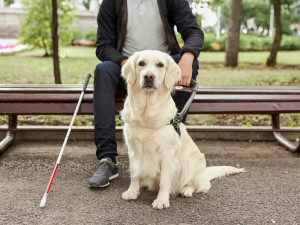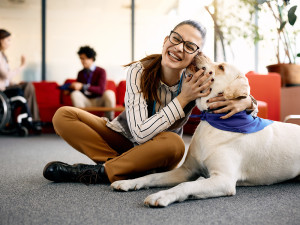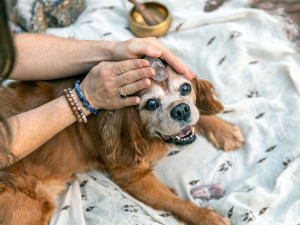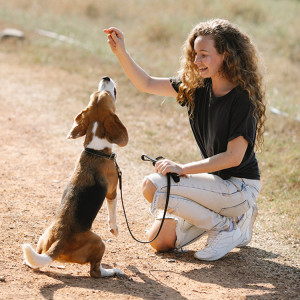How Psychiatric Assistant Dogs Help Their Humans
“A PAD can be life-changing – and even life saving”
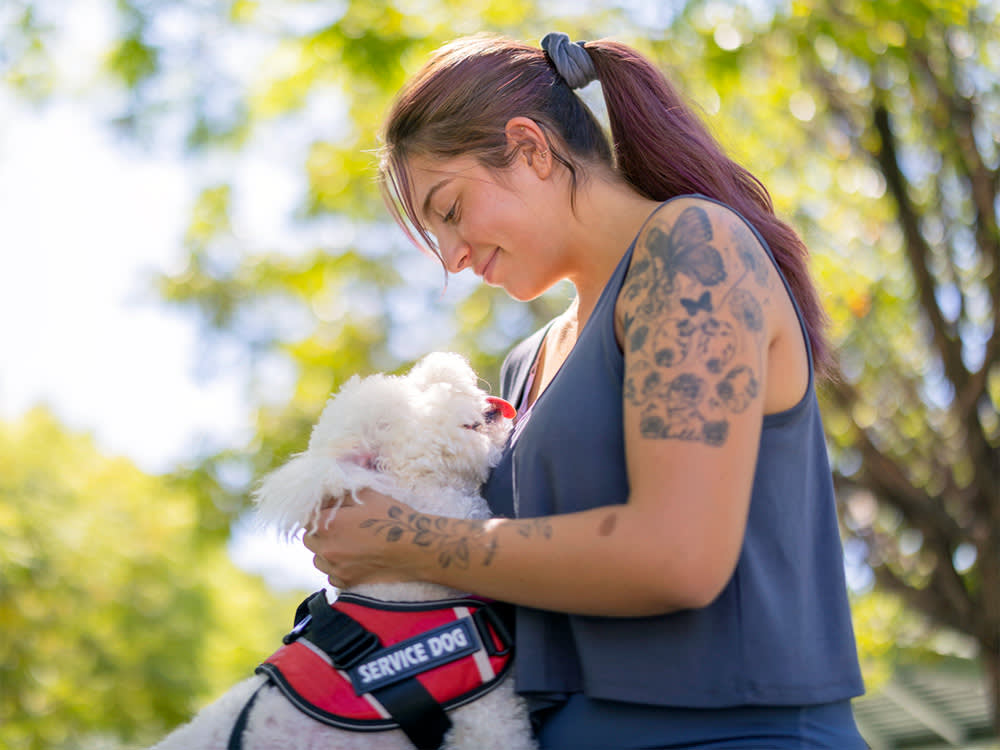
Share Article
We all know that dogs are special creatures, with an innate ability to cheer us up when we’re feeling down. But some extra-special dogs can be trained to help people living with mental health conditions and mental illness to lead happier and more fulfilling lives…
We caught up with animal trainer Zoe Norquoy, who set up her charity, the Psychiatric Assistance Dogs Foundationopens in new tab, to provide an informative resource and help people train their dogs to become the life-saving heroes that we already knew they were. Plus, we get the intel from behaviourist Rima Chehlaoui BSc (Hons), PPG, ACAI, who is PADS Foundation’s canine development coordinator and has worked with owners to train up their dogs.
What exactly is a psychiatric assistance dog?
“A Psychiatric Assistance Dog (PAD) is a dog that’s trained to help someone with a long-term mental health diagnosis that severely impacts their day-to-day living,” explains Zoe.
“A PAD can be life changing – and even life saving,” says Rima. “They’re trained to perform specific tasks that help their owner with activities they struggle with – overall, making life more manageable and enjoyable.”
What tasks can psychiatric assistance dogs do?
The tasks a PAD can perform vary depending on the needs of their owner, explains Zoe, and each dog is trained in a bespoke way.
Rima gives the example of someone who suffers from social anxiety. “Their dog can provide distance between them and other people when out in public,” she says. “They can also act as if they need to get out of a situation to provide a ‘get out’ clause for their handler.” These are “mitigating or task-related behaviours”, explains Rima.
“Another example is someone who dissociates [a mental health condition where someone may experience loss of connection between thoughts, memories, feelings, surroundings, behaviour and identity], and their dog can lead them to safety.” For someone with Obsessive Compulsive Disorder (OCD), a dog can interrupt compulsive or repetitive behaviours, and for someone living with depression, their dog can provide comfort and fetch medication or other items for them.
PADs can also be trained to distract their person during anxiety attacks and even apply physical pressure with their body to help calm them. They can provide tactile grounding via nuzzling, provide comfort, interrupt self-harm and more.
How does a psychiatric assistance dog differ from a guide dog or other types of assistance dogs?
A PAD only differs from other types of assistance dogs in the specific tasks they’re trained to perform, explains Zoe. “For example, a medical alert dog is trained to alert their handler to a symptom of a medical condition, such as low blood sugar for hypoglycemia. A hearing dog will alert their handler to a doorbell or fire alarm or alarm clock, etc.”
Can your current dog become a psychiatric assistance dog?
Yes, technically your current dog may be able to become an assistance dog, but they must have basic training nailed and be under five years old. Rima uses the Kennel Club Good Citizens Dog schemeopens in new tab as the standard – they must have progressed through the puppy foundation to at least silver level. “Dogs are assessed by a qualified Kennel Club examiner,” explains Rima. “It isn’t a ‘pass’ or ‘fail’. It’s a pass or ‘not ready’, as they can always try again.”
Then, before they begin PAD training – to learn the specific tasks related to the owner’s mental health condition or mental illness – the dog needs to be trained in ‘public access’ behaviours, explains Rima. These are things like getting in and out of a car safely, navigating car parks, getting in and out of lifts, and having no reaction to things other dogs might bark at, like cats. “So basically, like how we’d want a normal pet dog to behave but on overdrive,” says Rima. “A well-behaved pet dog but with bells and whistles.”
Zoe says that the process can take at least two years, sometimes even three depending on the dog and how difficult the tasks they need to learn are. “It’s an intense process,” says Rima.
Does a psychiatric assistance dog have to be a specific breed?
Most breeds can be trained as a PAD, but not toy or brachycephalic (those with flat noses such as French Bulldogs) breeds. And for legal reasons, any dog on the banned breed list, which includes the recently added XL Bully, explains Zoe. “A Dachshund wouldn’t be suitable either, as they can’t travel up and down stairs without risk of injury to their backs.” It’s also important to consider the size of the dog, if you need them to lead you away from a situation, for example, they’ll need to be of a larger size. A potential PAD will also need to be signed off by a vet as healthy and suitable for the job.
Can a rescue dog become a psychiatric assistance dog?
This is dependent on the temperament of the dog, explains Rima. “It’s beneficial for them to be easy-going, friendly and amenable to support you in a wide variety of environments and circumstances.”
“If someone already has a rescue dog that meets our requirements, we won’t refuse them on to our training,” says Zoe. “However, we wouldn’t recommend getting a rescue dog in the hope that it would become your future assistance dog – some behavioural issues may be unknown to the rescue centre and can go unnoticed for some time when placed with a new guardian.”
Rima notes that it’s also important to bear in mind that even with the best will in the world, not all dogs will go on to pass the requirements to become a fully fledged assistance dog. “They may get quite far in the process and still stumble at the last hurdle,” warns Rima.
“There’s no guarantee that doing the training is going to end up with the dog being suitable,” says Zoe. Sometimes a dog’s character doesn’t fully show itself for the first year or so of their life or they may become timid or not fully engage with the training. “I always say the worst case scenario is that you’ll end up with a really well-trained dog – because you’ll have worked through all the training together.” Plus, they’ll still provide all the comfort you need at home.
Are psychiatric assistance dogs legally recognised in the UK?
An assistance dog should be allowed into places that usually don’t allow pets. Although not required by law, it may be helpful to get an ID tag, harness or lead slip that states they’re a PAD. But they must behave impeccably at all times, and can be ejected if they don’t maintain the high behavioural standards of an assistance dog.
When it comes to renting a property, “a landlord may be required to make changes to any policies that disadvantage a tenant because of their disability,” says Rima. “This includes making changes to a tenancy agreement – for example, saying pets aren’t allowed in the property should be changed to allow a disabled person to have their assistance dog.” FYI, a landlord also can’t increase rent or charge additional cleaning fees for assistance dogs – even if a contract states they charge extra for pet fees. “A PAD shouldn’t be treated as a pet in this context,” explains Rima.
If you want to take your assistance dog on a flight, Zoe recommends doing further training, but they should be allowed in the cabin with you. “Check with the airline,” says Zoe, “as many will ask for evidenced training by a qualified professional.”
A beautiful future with a PAD
“It’s rewarding to see a dog enjoying their work and the handler's life opening up,” says Rima. “One owner I worked with had severe anxiety – it was isolating her and stopping her from leaving the house. With the help of her dog, she could start going out and about. The dog provided space between her and people in public, and would lie against her leg when she sat down, easing her anxiety and offering reassurance. It was lovely to see her start enjoying life.”
PADS Foundationopens in new tab is a volunteer-run charity that provides a wealth of information about Psychiatric Assistance Dogs and helps people with mental health conditions (signed off by a doctor or psychiatrist) to train their dogs to become fully fledged, legally recognised assistance dogs.

Alice Snape
Alice Snape is a freelance writer and editor whose work has featured in Cosmopolitan, Metro, Red, Vice, amongst other publications. Her rescue dog Lucy is the love of her life – probably because she’s an anxious weirdo like her. You’ll likely find them both curled up in bed – Alice’s favourite place to write from – or out having an adventure together in the park…
Related articles
![Curly haired woman with tattoos holding her Labradoodle dog up to her face in a tender embrace]()
How Deep Is the Love For Our Dogs?
The connection between people and dogs is the stuff of legends
![a woman in glasses smiles and sits cross-legged hugging a dog with a neckerchief]()
Can I Register My Dog As a Service Dog?
If you’re considering applying for an assistance dog, or you have a dog that assists you in your daily life, here’s everything you need to know
![A woman sitting on a bed holding a dog close in her arms.]()
Humans + Dogs: The Longest Love Story
How we became human – an ongoing exploration
![Healing stone on Cavalier spaniel dog.]()
6 Human Wellness Trends Making Their Way Into the Pet Space
Your pet can benefit from your self-care practices, from supplements to acupuncture
![Female dog trainer raising a treat above a beagle dog's head]()
Your Dog’s Trauma Triggers Are Everywhere. Fear Free Training Can Help
The founder of Fear Free Pets, Dr Marty Becker, on how this method makes vet visits, training sessions and grooming appointments less stressful for pets
On the Autism Spectrum? Consider Getting a Dog
Dr Annie Bowes, a vet on the spectrum, explains: “Dogs sense the world like we do, and don’t judge us”

